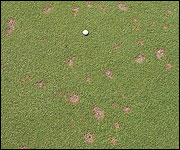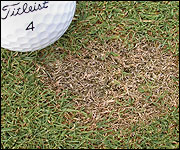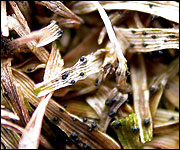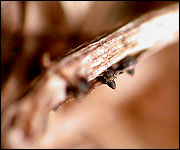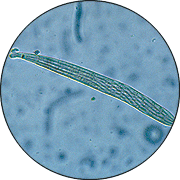Dead spot
Symptoms and signs | Conditions | Management
Dead spot is a disease of new sand-based bentgrass greens or renovated greens where methyl bromide was used in the renovation. The disease first occurs one to four years after construction or renovation, gradually disappearing one to three years after its first occurrence. Dead spot has also been reported in Texas and Florida on hybrid bermudagrass greens that were overseeded with rough bluegrass.
Pathogen
- Ophiosphaerella agrostis
Hosts
- Primarily bentgrass
- Hybrid bermudagrass
Symptoms can be confused with those of
- Copper spot
- Dollar spot
- Ball marks
- Cutworms
Symptoms and signs
The first symptoms of dead spot on bentgrass appear as reddish brown patches about 1/2 inch in diameter (Figure 1). The patches are most common on mounds, ridges, slopes and other historically dry areas on the putting surface. The diameter of the patches never gets much larger than 3 inches, and the patches do not coalesce. The patches are often sunken, interfering with putting quality. In the early stages of disease development, the small patches may be mistaken for ball marks or copper spot. As the disease progresses, the inner area of the patch turns light tan and at this stage can resemble dollar spot (Figure 2). When the fungus is active, the outer margins of the patch are red-brown to orange.
Disease generally starts in May, continuing throughout the summer until the first hard frost. Disease incidence varies among locations of greens, and the number of infection sites per green can range from a few to several hundred. New growth into the patch is inhibited, so recovery is slow.
All plant parts become infected, including leaves, leaf sheaths, roots and stolons. Unlike the dollar spot fungus, Ophiosphaerella agrostis generally does not produce visible mycelium (mass of fungal vegetative growth) in the field. One can sometimes observe a pink to white mycelium when plugs with symptoms are incubated in a moist chamber for several days.
Pseudothecia (fruiting bodies) develop in abundance in leaves, leaf sheaths and stolons (Figure 3). The pseudothecia are darkly pigmented, flask-shaped structures detectable with a hand lens (Figure 4). Ascopores are produced in pseudothecia in saclike structures (asci) (Figure 5). Mature ascospores are forcibly discharged or exude from the fruiting bodies under conditions of high relative humidity. Ascospores are easily spread by rainfall and irrigation water to initiate new infection sites.
Conditions
Dead spot most commonly occurs on new greens or greens treated with methyl bromide during a renovation project. The disease has not been observed on fairways with underlying native soil. The disease gradually disappears, presumably in response to the buildup of competitive microorganisms in the new or fumigated root zone.
Dead spot is a high-temperature (77 to 86 degrees F), low-moisture disease in which symptoms most commonly occur on areas of the green most prone to drying.
Management
Dead spot has been reported on nearly all commonly used creeping bentgrass cultivars. Although there is some variability in cultivar susceptibility, dead spot can probably be expected to occur under any new construction, irrespective of the cultivar.
When only a few patches are observed, remove the infection center by plugging out and disposing of the plugs.
When disease incidence is high, the use of fungicides at weekly intervals may be necessary to protect putting quality. Refer to Table 5 for a list of fungicides labeled for control of dead spot. Fungicide application will suppress the activity of O. agrostis, but generally will not speed recovery of infection sites. Tank mixing a low rate of nitrogen with the fungicide has been shown to promote recovery.
There is some evidence that dead spot severity is lower when ammonium sulfate is used as the primary nitrogen source, whereas nitrate forms of nitrogen may result in more severe disease. This is probably related to changes in pH at the rhizosphere level. Amonium sulfate generally lowers rhizosphere pH in contrast to nitrate forms, which generally result in higher pH at the rhizosphere.
